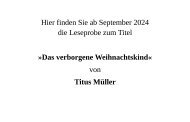Michael Welker | Eva Winkler | John Witte, Jr. | Stephen Pickard (Eds.): The Impact of Health Care (Leseprobe)
Pluralism has become the defining characteristic of many modern societies. Not only a plurality of individual and social claims and activities gain impacts on societal life. A creative pluralism of institutions and their norms profoundly shape our moral commitments and character – notably the family, the market, the media, and systems of law, religion, politics, research, education, health care, and defense. In the theoretical, empirical, and historical contributions to this volume, specialists on medicine, medical ethics, psychology, theology and health care discuss the many challenges that major transformations in their areas of expertise pose to the communication and orientation in late modern pluralistic societies. Contributors come from Germany, the USA and Australia.
Pluralism has become the defining characteristic of many modern societies. Not only a plurality of individual and social claims and activities gain impacts on societal life. A creative pluralism of institutions and their norms profoundly shape our moral commitments and character – notably the family, the market, the media, and systems of law, religion, politics, research, education, health care, and defense.
In the theoretical, empirical, and historical contributions to this volume, specialists on medicine, medical ethics, psychology, theology and health care discuss the many challenges that major transformations in their areas of expertise pose to the communication and orientation in late modern pluralistic societies. Contributors come from Germany, the USA and Australia.
Create successful ePaper yourself
Turn your PDF publications into a flip-book with our unique Google optimized e-Paper software.
Ethical Tensions in the Medical<br />
Treatment <strong>of</strong> Elderly Patients in<br />
Geriatrics and Geriatric Psychiatry<br />
Christine Thomas<br />
<strong>The</strong> medical care <strong>of</strong> elderly patients is first <strong>of</strong> all characterized by along life<br />
history and the associated manifold experiences <strong>of</strong> the subjective perception <strong>of</strong><br />
illness and health, as well as confrontation with objectively diagnosed—though<br />
<strong>of</strong>ten denied—chronic diseases. Experiences <strong>of</strong> one’s own and other people’s<br />
phases <strong>of</strong> illness,care situations,and the company <strong>of</strong>close relatives in illnesses<br />
over the entire life span into aging and finally into atimely or untimely death all<br />
bear the potential for conflict over apatient’s sovereignty <strong>of</strong> interpretation and<br />
decision-making, both between the generations and between medical and therapeutic<br />
practitioners. Fears <strong>of</strong> lost status and autonomy because <strong>of</strong> chronic illness,<br />
disability, or neurodegenerative diseases, such as Parkinson’s disease or<br />
dementia, <strong>of</strong>ten hinder unconditional openness to consultation and care. Differences<br />
in objective assessments and subjective perceptions <strong>of</strong> resources and competencies<br />
<strong>of</strong>ten result in (unrealistic) concerns about the excessive care burden<br />
on close relatives or the financial strain <strong>of</strong> nursing home costs and other related<br />
expenses. <strong>The</strong> interests <strong>of</strong> patients themselves <strong>of</strong>ten differ from those <strong>of</strong> their<br />
relatives or following generations.<br />
In caring for the elderly and people with chronic disabilities, tensions arise<br />
from the interplay <strong>of</strong> their self-esteem with the role they or others ascribe to<br />
them in the family, the quality <strong>of</strong> life the patients themselves perceive, and their<br />
attitudes toward therapy risks, therapy limitation, containment <strong>of</strong> suffering, and<br />
even aself-determined end <strong>of</strong> life.<br />
Demographic developments, with further increases in life expectancy, are<br />
leading to arise in the number <strong>of</strong>old and very old patients. At the same time,<br />
modern medicine, with minimally invasive procedures, secondary prevention,<br />
and broad diagnostics, has come along way in developing treatment <strong>of</strong> older<br />
patients. Patients over the age <strong>of</strong> sixty-five make up the majority <strong>of</strong> hospital patients.<br />
However, the increase in “healthyyears” also leads to increasing economic<br />
pressure on hospitals, health-insurance companies, and outpatient and inpatient<br />
care providers, as well as on the entire health-care system and society.
















